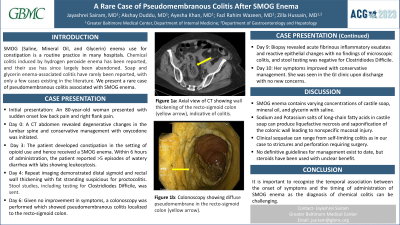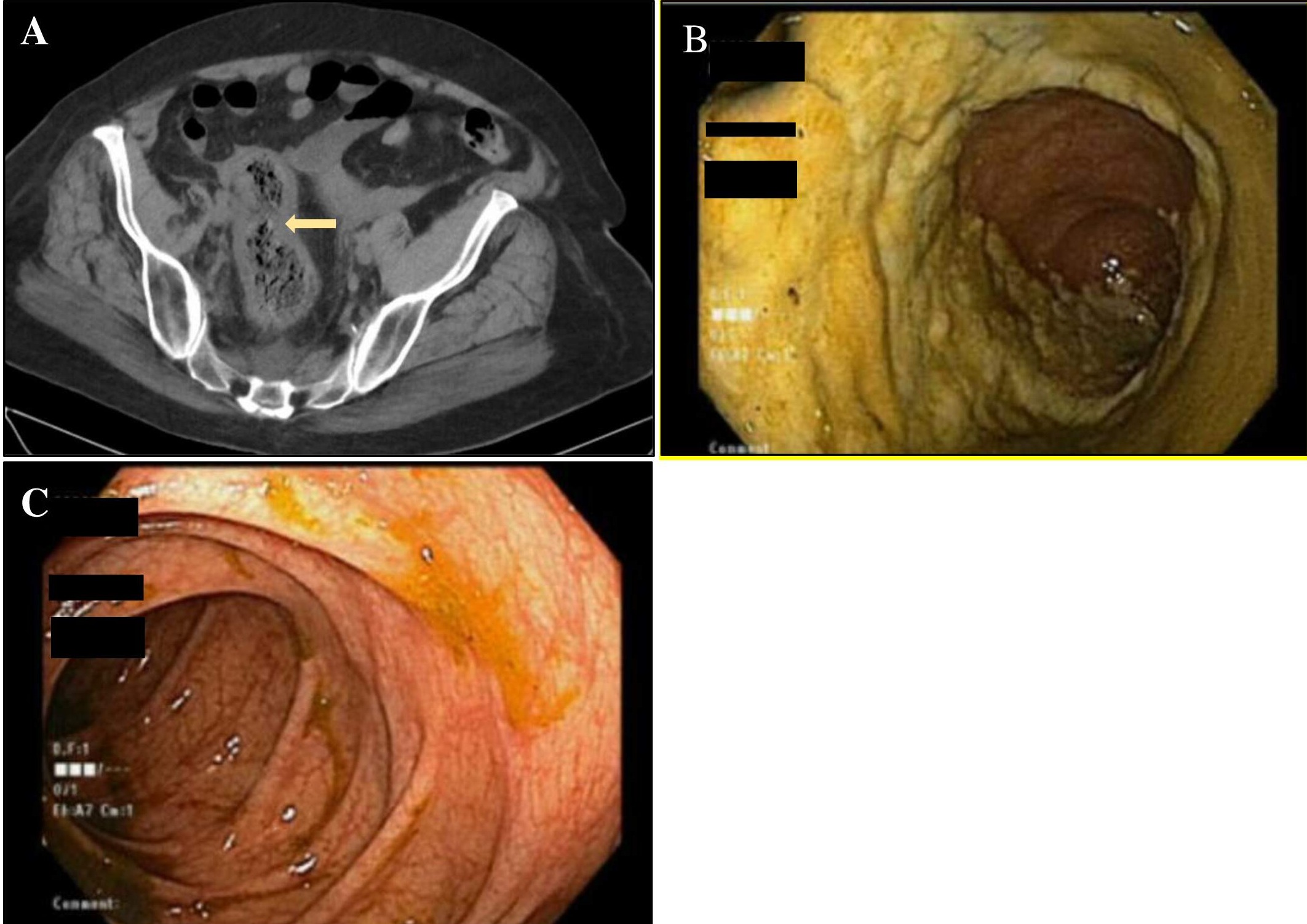Monday Poster Session
Category: Colon
P1658 - A Rare Case of Pseudomembranous Colitis After SMOG Enema
Monday, October 23, 2023
10:30 AM - 4:15 PM PT
Location: Exhibit Hall

Has Audio
- JS
Jayashrei Sairam, MD
Greater Baltimore Medical Center
Towson, MD
Presenting Author(s)
Jayashrei Sairam, MD, Akshay Duddu, MD, Ayesha Khan, MD, Fazl Rahim Wazeen, MD, Zilla Hussain, MD
Greater Baltimore Medical Center, Towson, MD
Introduction: The use of SMOG (Saline, Mineral Oil, Glycerin) enema for constipation is a routine practice in many hospitals. Chemical colitis induced by hydrogen peroxide enema has been reported and their use has largely been abandoned. Soap and glycerin enema-associated colitis have rarely been reported with only a few cases existing in the literature. We present a rare case of pseudomembranous colitis associated with SMOG enema.
Case Description/Methods: An 80-year-old woman with a history of lumbar degenerative disc disease presented with sudden onset severe lower back pain and flank pain. A CT abdomen showed severe degenerative changes in the lumbar spine and conservative management with oxycodone was initiated. She later developed constipation in the setting of opioid use and received a SMOG enema. Within 6 hours of enema administration, the patient reported multiple episodes of watery diarrhea. She was noted to have lower abdominal tenderness and labs revealed leucocytosis of 11 x10³/µL. A repeat CT demonstrated distal sigmoid colon and rectal wall thickening with surrounding fat stranding suspicious for proctocolitis, not seen on her previous CT. Stool studies were sent and she was initiated on IV antibiotics due to concern for infectious colitis. Given no improvement in her symptoms, the patient underwent a colonoscopy that showed diffuse pseudomembranous colitis in the recto-sigmoid region. She was empirically started on oral vancomycin, which was discontinued after Clostridiodes difficle testing returned negative. Biopsy revealed acute fibrinous-inflammatory exudate and reactive epithelial changes with no evidence of microscopic colitis. Her symptoms improved with conservative management, and she was followed up in the GI clinic with no return of her symptoms.
Discussion: SMOG enema contains varying concentrations of castile soap, mineral oil, and glycerin with saline. Sodium and potassium salts of long-chain fatty acids present in castile soap can produce liquefaction necrosis and saponification of the colonic wall leading to a nonspecific pattern of mucosal injury. Clinical sequelae can range from self-limiting colitis to strictures and perforations requiring surgery. No definitive guidelines exist in the literature for the management of chemical colitis, but steroids have been used with no clear benefit. It is important to recognize the temporal association between the development of symptoms and the time of administration of the enema as the diagnosis of chemical colitis can be challenging.

Disclosures:
Jayashrei Sairam, MD, Akshay Duddu, MD, Ayesha Khan, MD, Fazl Rahim Wazeen, MD, Zilla Hussain, MD. P1658 - A Rare Case of Pseudomembranous Colitis After SMOG Enema, ACG 2023 Annual Scientific Meeting Abstracts. Vancouver, BC, Canada: American College of Gastroenterology.
Greater Baltimore Medical Center, Towson, MD
Introduction: The use of SMOG (Saline, Mineral Oil, Glycerin) enema for constipation is a routine practice in many hospitals. Chemical colitis induced by hydrogen peroxide enema has been reported and their use has largely been abandoned. Soap and glycerin enema-associated colitis have rarely been reported with only a few cases existing in the literature. We present a rare case of pseudomembranous colitis associated with SMOG enema.
Case Description/Methods: An 80-year-old woman with a history of lumbar degenerative disc disease presented with sudden onset severe lower back pain and flank pain. A CT abdomen showed severe degenerative changes in the lumbar spine and conservative management with oxycodone was initiated. She later developed constipation in the setting of opioid use and received a SMOG enema. Within 6 hours of enema administration, the patient reported multiple episodes of watery diarrhea. She was noted to have lower abdominal tenderness and labs revealed leucocytosis of 11 x10³/µL. A repeat CT demonstrated distal sigmoid colon and rectal wall thickening with surrounding fat stranding suspicious for proctocolitis, not seen on her previous CT. Stool studies were sent and she was initiated on IV antibiotics due to concern for infectious colitis. Given no improvement in her symptoms, the patient underwent a colonoscopy that showed diffuse pseudomembranous colitis in the recto-sigmoid region. She was empirically started on oral vancomycin, which was discontinued after Clostridiodes difficle testing returned negative. Biopsy revealed acute fibrinous-inflammatory exudate and reactive epithelial changes with no evidence of microscopic colitis. Her symptoms improved with conservative management, and she was followed up in the GI clinic with no return of her symptoms.
Discussion: SMOG enema contains varying concentrations of castile soap, mineral oil, and glycerin with saline. Sodium and potassium salts of long-chain fatty acids present in castile soap can produce liquefaction necrosis and saponification of the colonic wall leading to a nonspecific pattern of mucosal injury. Clinical sequelae can range from self-limiting colitis to strictures and perforations requiring surgery. No definitive guidelines exist in the literature for the management of chemical colitis, but steroids have been used with no clear benefit. It is important to recognize the temporal association between the development of symptoms and the time of administration of the enema as the diagnosis of chemical colitis can be challenging.

Figure: Image 'A' shows wall thickening of the recto-sigmoid colon (yellow arrow) indicative of colitis. Image 'B' shows a diffuse pseudomembrane in recto-sigmoid colon. Image 'C' shows the remainder of the colon appearing normal.
Disclosures:
Jayashrei Sairam indicated no relevant financial relationships.
Akshay Duddu indicated no relevant financial relationships.
Ayesha Khan indicated no relevant financial relationships.
Fazl Rahim Wazeen indicated no relevant financial relationships.
Zilla Hussain indicated no relevant financial relationships.
Jayashrei Sairam, MD, Akshay Duddu, MD, Ayesha Khan, MD, Fazl Rahim Wazeen, MD, Zilla Hussain, MD. P1658 - A Rare Case of Pseudomembranous Colitis After SMOG Enema, ACG 2023 Annual Scientific Meeting Abstracts. Vancouver, BC, Canada: American College of Gastroenterology.

